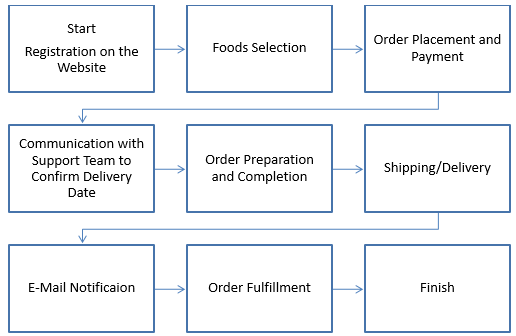While designing a grocery business, it is important to determine such competitive priorities as the on-time delivery, the delivery speed, flexibility in partnerships, and the top quality. In core processes, the capabilities to develop are the achievement of the on-time speedy delivery in relations with suppliers and partners, including food stores, and relations with customers. Moreover, it is important to develop flexible relations and communications with suppliers, partners, and customers. In the online order fulfillment, the focus is on proposing only high-quality foods that are delivered appropriately and on time (Krajewski, Malhotra, & Ritzman, 2015, p. 7). In support processes, the capabilities to develop include the effective scheduling and resource allocation to guarantee the on-time delivery.
The project can have one and more critical paths. When a project has multiple critical paths, project risks increase according to the number of paths. There are risks of decreasing capabilities, increasing costs, and decreasing the accuracy of the project management and monitoring. In this case, the total available slack can remain stable because several critical paths are usually realized in complex projects simultaneously. It is important to state that the resource dependencies increase as more resources are required to complete multiple paths (Jacobs, Chase, & Chase, 2010). As a result, the management of multiple critical paths also increases the project manager’s responsibilities regarding the costs and resources’ distribution and monitoring.

- Step 1 – The start and registration of the customer/partner on the grocery business website.
- Step 2 – The selection of required foods.
- Step 3 – The order placement, provision of the address, and payment.
- Step 4 – The support team contacts the store to confirm the address information, payment provision, and the delivery date.
- Step 5 – The process of preparing the order according to the customer’s requirements.
- Step 6 – The process of delivering the order to the customer.
- Step 7 – The e-mail notification to inform about the order shipping.
- Step 8 – The customer/store receives the order.
The Just-in-Time (JIT) inventory control model is used to minimize the amount of the utilized inventory in the organization. Company A operates the limited inventory which is required to cover the customers’ needs. Economic Order Quantity (EOQ) model is used to determine the annual limits for the inventory in Company B to reduce the ordering costs (Russell & Taylor, 2013). They differ in terms of focusing on addressing the customers’ orders with the right quantity of inventory (JIT) and focusing on the fixed inventory amount (EOQ). While working with these companies, it is important to remember that Company B can fail to provide the required number of products on time if the order is changed and does not correspond with the fixed inventory.
To guarantee the quality of products and services, it is necessary to implement such Quality Control processes as the use of control charts and the identification of the process capability index. The Six Sigma Model can also be used to improve the quality of services (Galloway, Rowbotham, & Azhashemi, 2012). The measurement metrics include the number of non-fulfilled orders, the number of orders fulfilled with defects, and the number of orders not delivered on time among others.
The efficiency measures to refer to in the business development are the productivity as the possibility to complete a planned number of orders and the throughput as a possibility to work with a large number of customers at a time. The analysis tools appropriate to measure productivity include ratios (Krajewski et al., 2015). In addition, it is important to utilize such tools as the Pareto diagram, bar graphs, and histograms in order to analyze the efficiency and control the performance.
References
Galloway, L., Rowbotham, F., & Azhashemi, M. (2012). Operations management in context. New York, NY: Routledge.
Jacobs, F. R., Chase, R. B., & Chase, R. (2010). Operations and supply chain management. New York, NY: McGraw-Hill/Irwin.
Krajewski, L. J., Malhotra, M. K., & Ritzman, L. P. (2015). Operations management: Processes and supply chains. New York, NY: Prentice Hall.
Russell, R., & Taylor, B. (2013). Operations and supply chain management. New York, NY: John Wiley & Sons, Inc.